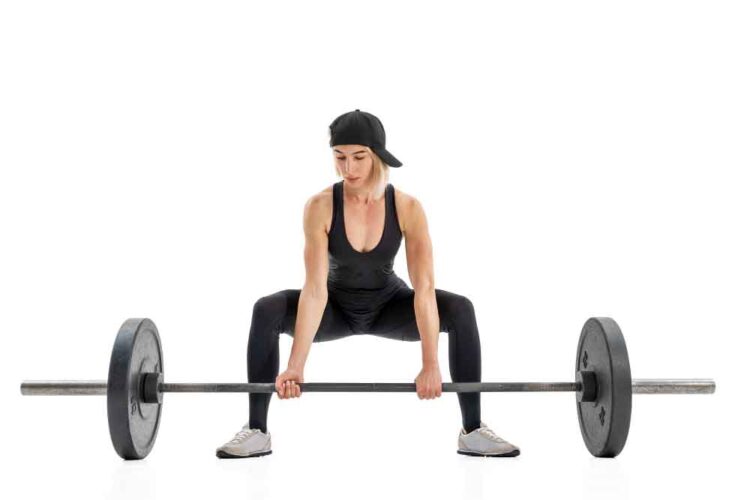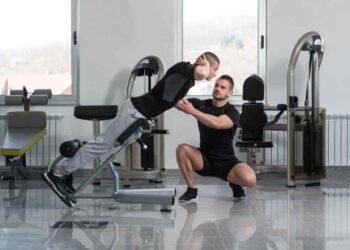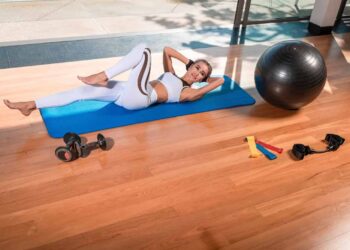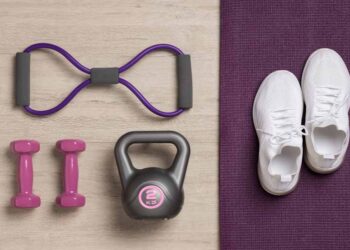Are you looking for a workout move that targets multiple muscle groups, builds strength, and promotes overall muscle growth? Look no further than the deadlift! Often regarded as the best exercise of all time, deadlifts are a must-have in any strength training routine. But what makes them so special?
Deadlifts engage your lower back, glutes, and hamstrings, while also working your quadriceps, forearms, latissimus dorsi, and upper back. They require grip strength and place a significant amount of stress on your central nervous system. With the potential for substantial strength and muscle growth, deadlifts are truly essential.
Discover everything you need to know about deadlifts in this comprehensive guide. From the anatomy behind this powerhouse exercise to the correct form and technique, we’ll dive deep into the world of deadlifts. Get ready to unlock their full potential and take your workout to new heights!
Key Takeaways:
- Deadlifts engage multiple muscle groups, making them a highly effective compound movement.
- The exercise primarily targets the lower back, glutes, and hamstrings, while also engaging the forearms, quadriceps, latissimus dorsi, and upper back.
- Deadlifts require grip strength and place a significant amount of stress on the central nervous system.
- Proper form and technique are crucial to maximize the benefits and minimize the risk of injury.
- Incorporating deadlifts into your workout routine can lead to substantial strength and muscle growth.
Anatomy Lesson: The Muscle Group
Deadlifts are a compound exercise that targets multiple major muscle groups, making them a highly effective movement for overall muscle growth and strength development. Understanding the muscles involved in the deadlift can help you optimize your form and maximize your results.
The Lower Back and Core
The deadlift primarily targets the lower back muscles, also known as the spinal erectors. These muscles play a crucial role in maintaining a stable and upright posture throughout the lift. Engaging your lower back and core muscles is essential for maintaining a strong and safe position throughout the movement.
The Glutes and Hamstrings
The glutes (buttocks) and hamstrings (the muscles at the back of your thighs) are heavily engaged during the lifting motion of the deadlift. These muscle groups are responsible for hip extension, which is crucial for generating power and lifting the weight. Strengthening the glutes and hamstrings through deadlifts can improve your overall lower body strength and athleticism.
The Forearms and Grip Strength
While deadlifts primarily target the lower body, they also require significant involvement of the forearms and grip strength. Maintaining a secure grip on the barbell is essential for a successful deadlift. The forearms play a vital role in holding onto the bar, especially when lifting heavy weights. Over time, deadlifts can help improve your grip strength, allowing you to lift and hold heavier loads.
The Quadriceps and Upper Back
Integral to the deadlift are the quadriceps, the muscles in the front of your thighs. These muscles assist with the initial push off the floor, helping you stand up with the weight. The latissimus dorsi (commonly known as lats) and upper back muscles also play a role in deadlifts by providing stability and keeping your spine in a neutral position throughout the movement.
Additional Muscles Activated
While the aforementioned muscle groups are the primary focus of the deadlift, several other muscles are also activated to provide stability and support during the exercise. These include the abdominal muscles (abs) and shoulders, which help maintain proper posture and stability throughout the lift.
The deadlift places a high demand on the central nervous system due to the significant muscle recruitment and overall intensity of the exercise. This makes it important to allow for adequate recovery between deadlift sessions to avoid overtraining and ensure optimal progress.
By targeting multiple muscle groups simultaneously and placing a high demand on the body’s major systems, deadlifts are an effective exercise for overall muscle growth, strength development, and functional fitness.
| Muscle Group | Primary Involvement |
|---|---|
| Lower Back (Spinal Erectors) | Maintains stability and posture |
| Glutes | Hip extension for generating power |
| Hamstrings | Hip extension for generating power |
| Forearms | Grip strength and barbell control |
| Quadriceps | Assist with standing up with the weight |
| Latissimus Dorsi (Lats) | Provides stability and upper back support |
| Upper Back | Provides stability and upper back support |
| Abdominal Muscles (Abs) | Provides core stability |
| Shoulders | Provides stability and upper body support |
| Central Nervous System | Coordination and muscle recruitment |
The Deadlift in General
The conventional deadlift is the most common variation of the exercise. Proper setup and form are crucial to prevent injury and maximize performance.
To begin the deadlift, place your feet shoulder-width apart with toes slightly turned out. Grasp the barbell with a double overhand grip, slightly wider than hip-width apart, keeping the arms straight.
The setup also involves positioning the hips and back correctly. Hinge at the hips while maintaining a flat back, with the shins touching the bar.
The spine should remain in a neutral position throughout the lift, without rounding or overextending. Engage the core for stability by tensing the abs and maintaining a neutral head position.
The barbell should travel in a straight line, close to the body, with the contact maintained between the barbell and shins. Proper form and technique are essential for safety and optimal performance.
Image of a barbell to accompany the description of the deadlift setup and form.
| Aspect | Key Points |
|---|---|
| Foot Placement | Feet shoulder-width apart, toes slightly turned out |
| Barbell Grip | Double overhand grip, slightly wider than hip-width apart, arms straight |
| Hip Position | Hinge at the hips, maintaining a flat back, shins touching the bar |
| Back Position | Neutral spine throughout the lift, without rounding or overextending |
| Core Stability | Engage the core by tensing the abs for stability |
| Bar Path | Barbell travels in a straight line, close to the body, maintaining contact with the shins |
Table: Key Points for Proper Deadlift Setup and Form
Progressive Pulls: Enhancing the Deadlift
Progressive pulls, a technique within the 5/3/1 training method, can be a game-changer when it comes to enhancing deadlift performance and promoting hypertrophy. This approach offers a strategic and effective way to progress in your deadlifts, allowing you to achieve impressive results.
Traditional deadlift variations such as power cleans and high pulls can be challenging for beginners due to their technical demands. That’s where modified progressive pulls come in. By starting with a more accessible exercise, such as strict barbell rows, you can build strength, stability, and familiarity with the movement pattern.
When incorporating progressive pulls, begin with strict barbell rows, focusing on moderate to high reps in the 5-8 range. This allows you to build a solid foundation of strength in the back and hamstrings, which are key muscles involved in the deadlift.
“Progressive pulls are all about strategic progress and pre-fatiguing the right muscles. They help you build the necessary strength for deadlifts while minimizing the risk of injury.” – Fitness Expert
Once you reach a point where you can no longer perform strict barbell rows with proper form, it’s time to transition to deadlifts themselves. Aim to stick with sets of 5-8 reps, which strikes a balance between strength and hypertrophy goals.
Accessory work is another valuable component of progressive pulls. By targeting specific muscle groups with focused exercises, you can further strengthen the muscles involved in the deadlift and improve overall performance. Examples of effective accessory work for deadlifts include Romanian deadlifts, single-leg deadlifts, and glute bridges.
Example Progressive Pulls Workout
| Exercise | Sets x Reps | Intensity |
|---|---|---|
| Strict Barbell Rows | 3 x 8-10 | Medium |
| Deadlifts | 3 x 5-8 | High |
| Romanian Deadlifts | 3 x 10-12 | Medium |
| Single-Leg Deadlifts | 3 x 8-10 each leg | Low |
| Glute Bridges | 3 x 12-15 | Low |
With the right programming and consistent effort, progressive pulls can be a valuable tool in your deadlift training toolkit. By gradually increasing the challenge and incorporating accessory work, you’ll enhance your strength, promote muscle growth, and make significant progress in your deadlifts.
Conclusion
Deadlifts are a fundamental exercise that should be integrated into strength training routines. Combining deadlifts with the structured progression of the 5/3/1 training method ensures consistent results over time. By focusing on the big lifts and following specific rep and set ranges, the 5/3/1 method optimizes deadlift progression during each week of the mesocycle.
The 5/3/1 method offers clear benefits, including visible and measurable results. By gradually increasing weights and incorporating accessory work, this approach promotes strength gains and hypertrophy. Structured progression minimizes the risk of ego lifting and ensures safe and effective workouts.
Another advantage of the 5/3/1 method is its time efficiency. With a well-designed program, deadlift training can be completed within a reasonable timeframe, maximizing productivity in the gym. Additionally, the psychological benefits of deadlifts and the 5/3/1 method should not be overlooked. Seeing progress and achieving personal records boosts self-esteem and motivation, fostering a positive mindset to continue the fitness journey.
So, whether your goal is building strength or gaining muscle, incorporating deadlifts and the 5/3/1 training method into your workout routine can be a valuable investment. With its structured progression, clear results, time efficiency, and psychological benefits, this approach provides a solid foundation for achieving your fitness goals.












